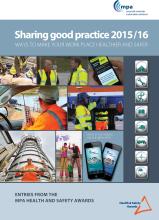Good housekeeping at a quarry site will greatly reduce the risk of accidents.
Maintaining a tidy working environment is a major step towards reducing or eliminating accidents in the workplace. Incidents such as slips, trips and falls can be eliminated with a good housekeeping procedure. This will include identifying and then tackling the relevant issues to prevent such incidents, says Blackwood Quarry Engineering, which offers companies support to do this as a matter of course, drawing up a housekeeping checklist following a risk assessment.
“Such a list can be amended for a particular site or as any further problems become known. Maintaining a safe working environment in the quarry or aggregate industry is critical,” says the company.
The
“We audit sites using a common tool and inspection checklist and process the results in order to establish best practices,” says Lafarge.
In 2011, the Yali pumice quarry was one of 19 sites chosen for participation in the company’s 2011 housekeeping project. It is the biggest pumice quarry in the world but is located on an island which has restricted access; is hampered by poor weather, and lacks the communication systems found in other locations in Greece.
The quarry is run by Lava Mining & Quarrying of the Heracles Group of Companies, which is a member of the Lafarge Group.
The housekeeping project started with an audit by members of the executive committee, frequent visits by Lava management, health and safety inspections and record-keeping, and this in turn generated an improvement plan.
Project delivery was improved by a more formal approach to CapEx investment and the instigation of annual shutdowns. In the first year, signage was improved, storage completely reorganised and categorised, and 150tonnes of scrap material moved to suitable disposal and recycling sites, all in accordance with Contractor Safety Management standards. A waste recycling area was established.
The project increased health and safety awareness, involvement and accountability at the site, with the creation of an on-site health and safety supervisor and regular meetings with the Lava management, and by the end of 2011 the site had achieved a score of 77% on the housekeeping project scale, compared with 44% at the outset in 2010.
The Yali site was in the top three of those nominated for the relevant Lafarge award.
“Other sites in the housekeeping project have achieved improvements on a similar scale, if not quite so dramatic,” says Lafarge, which said it then planned to extend the project to further sites, including those in its aggregates and concrete businesses.
The
“Simple measures can be taken to reduce the risk of injury. Where possible, the aim should be to eliminate the risk at source,” says the agency.
Maintaining a safe working environment in the quarry or aggregate industry is critical. Inadequate walkways or scaffolding, poor housekeeping and/or lack of training often cause frequent injuries, says
“Even when careful, it is easy to slip and fall causing a muscle strain or back injury,” says the company.
“Caterpillar is committed to safety and has created a variety of industry specific safety awareness materials including the Slips and Falls video. Caterpillar designed the series of Safety Basics videos to help users understand proper safety procedures. They include wearing the appropriate personal protective equipment such as hard hats, footwear and hand protection.”
British Safety Council Awards
The British Safety Council has formally launched its 2015 International Safety Awards, which are designed to recognise organisations worldwide who have demonstrated their commitment to ensuring the health, safety and well-being of their employees during the 2014 calendar year.
The awards are open to businesses and organisations of all sizes and industry sectors (in the UK and internationally) and last year 524 organisations from a wide range of industry sectors and countries won an International Safety Award, including businesses from the UK, Africa, Asia, Australia, the Middle East and the West Indies.
The awards generally relate to health and safety management at a specific site or business unit, and applicants answer a series of online questions about their management of health and safety risks.
Closing date for applications is 2 February, 2015 and the results will be announced on 26 February, 2015.
To apply go to: %$Linker:







